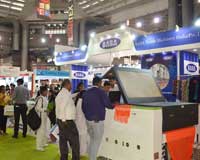FW
China is focusing on hemp cultivation. A research program involving partners from the Ukraine and Canada aims at developing new, high-yield hemp varieties for stalks and seeds and introducing biotechnological procedures which allow for the production of fine hemp fibers using enzymes.
This procedure is referred to as the enzymatic cottonisation of hemp fibers, which may then be processed alone or blended with other fibers. Hemp cultivation is considered more environmentally friendly than growing cotton, as it thrives in moderate climates, and doesn’t need artificial irrigation. Hemp is said to be ideally suited for crop rotation schemes and delivers around twice the fiber yield.
China feels hemp can be a strategic resource. The country is attracting partners from Europe and North America for the production and marketing of organic hemp foods and offering them solid infrastructure and investment subsidies. Hemp fibers have benefits including good moisture absorption characteristics, antibacterial effects. They provide good UV protection and allow textiles to dry fast.
Earlier this month, a conference on hemp was held in China. The show showcased very fine hemp fabrics including suits, jackets, dresses, trousers, underwear, socks and towels. Hemp viscose fibers were also presented – mixed with cotton they are used in wet and cosmetic wipes.
Bestseller has joined the Global Fashion Agenda, which aims to change the way the world produces, markets and consumes fashion. It operates as a leadership forum steering the global sustainability conversation.
As a strategic partner, Bestseller will advise on the strategic direction and help shape the operational focus of Global Fashion Agenda and provide expert opinion and inputs for the development of sustainability recommendations for fashion businesses. Global Fashion Agenda’s other strategic partners are H&M, Kering, Target, Sustainable Apparel Coalition and Li & Fung.
Global Fashion Agenda is best known for the Copenhagen Fashion Summit, the world’s principal event on sustainability in fashion. World apparel and footwear consumption is projected to rise 63 per cent by 2030. This increases the need for the fashion industry to address its environmental and social footprint and take remedial action. As of today, sustainability pulse of the industry is weak – scoring only 32 out of 100. The fashion industry has a clear opportunity to act differently, pursuing profit and growth while also creating new value for the world economy.
In the past decade, the global fashion industry has been an engine for development and made progress on sustainability. Awareness is growing and individually, companies are optimising business practices to limit their negative impact.
Bangladesh’s export earnings in July grew 26 per cent compared to the same period last year. Export earnings from knitwear increased by 17.28 per cent; earnings from woven sector grew 16.88 per cent. Leather and leather product exports grew 26 per cent. Earnings from leather footwear exports grew by 30 per cent while earnings from leather products increased by 38.43 per cent. Earnings from jute and jute goods declined 7.51 per cent.
Growth took place due to increased shipments of readymade garments. Earnings from RMG exports in July grew 17 per cent. There were two main reasons for the growth: some of seasonal goods shipped at a time in the month of July and, second, orders increased as capacity of Accord and Alliance approved factories increased.
Exports in fact witnessed double digit growth in July as a good number of export consignments for the month of June was shipped in the month of July due to the vacation of Eid-ul-Fitr. Export earnings growth are expected to be satisfactory in August but decline in September due to of Eid-ul-Azha vacation.
The Australian Cotton Industry Awards has declared winners. The recipients are: Cavaso Farming for Monsanto Grower of the Year, CSD Farming for AgriRisk High Achiever of the Year, Fiona Norrie for ADAMA Chris Lehmann Trust Young Achiever of the Year, Dr Paul Grundy and Dr Stephen Yeates for Cotton Seed Distributors Researcher of the Year and the IPF Service to Industry Award to Michael Bennett.
The awards recognises excellence and achievement in Australia’s cotton industry throughout the supply chain, from growers and ginners to product suppliers, consultants, agronomists and researchers. Meanwhile more than 500 cotton growers from across Queensland and NSW flocked to Southern New South Wales to discuss issues facing the industry and catch up on the latest developments in farming. The two-day cotton collective industry forum covered a huge range of topics, from research and development, connected agriculture and technology, to positioning Australian cotton in the world fiber market.
This year’s program and speaker line-up was extremely diverse, giving attendees a broad variety of topics covering many issues affecting cotton growers. The cotton industry has grown rapidly in southern New South Wales in recent years, with many farmers becoming cotton growers for the first time, so a significant portion of the collective’s agenda was devoted to issues important to new growers.
"With rapid movement of styles from catwalk to retail shelves, fast fashion is space in everyone’s wardrobe. And as Tasha Lewis, a professor at Cornell University’s Department of Fibre Science and Apparel Design says, the rate of new fashion cycles has accelerated to a feverish pace. It used to be four seasons in a year; now it may be up to 11 or 15 or more. At the helm of such a revolution are brands such as Forever 21, Zara and H&M. However, the industry is witnessing a major flux these days owing to stringent environmental and labour regulations."

With rapid movement of styles from catwalk to retail shelves, fast fashion is space in everyone’s wardrobe. And as Tasha Lewis, a professor at Cornell University’s Department of Fibre Science and Apparel Design says, the rate of new fashion cycles has accelerated to a feverish pace. It used to be four seasons in a year; now it may be up to 11 or 15 or more. At the helm of such a revolution are brands such as Forever 21, Zara and H&M. However, the industry is witnessing a major flux these days owing to stringent environmental and labour regulations.

Talking about their market share, H&M has experienced steady online market growth since 2014, although perhaps not quickly enough to compete with rapid risers like Torrid, ASOS and Zara in the long term. The most meteoric rise by far has been of Uniqlo, the Japanese brand which first appeared in New York City in 2006 and expanded aggressively across the country over the following decade.
H&M and Forever 21 have long been dubbed as millennials’ preferred choice. Forever 21 currently has higher online ranking in America than H&M. One key difference between the two is their age groups. Forever 21 shoppers are 118 per cent more likely than the average person to be younger Millennials, while H&M shoppers are 133 per cent more likely to be older Millennials. H&M could use this age distinction in several strategic ways. They might double- down on their 25-34 year old customer base, who are loyal to H&M and have more disposable income than young Millennials. It also turns out this age group skews heavily towards men for H&M, while Forever 21 actually struggles to reach older millennial men; this advantage could present an opportunity for H&M to eclipse Forever 21 by releasing a slightly more upscale male clothing line.
Consumers’ shifting mindset
Rising consumer concerns on growing eco-consciousness would majorly drive their future growth across the world. Between 2015 and 2016, traffic to the fast fashion industry dropped in step with the release of ‘True Cost’, a documentary about the impact of the retail industry on the planet (and which called out brands like H&M and Zara directly). As a response, several brands such as H&M announced take-back programs that collect used clothing to be recycled or re-sold. However, the success of these programs is still a question mark.
Unhealthy working conditions are also putting fast fashion industry into bad light. This ethical question remains unresolved for the fast fashion industry, and would manufacturers to shift their priorities and be a responsible eco company. For brands willing to innovate in their manufacturing procedures, transparency and sustainability initiatives, this could become a differentiating opportunity.
What does the future hold?
Experts say, affordable clothing will always have a market but financial pressures and consumer priorities are undoubtedly casting doubts around the sustainability of fast fashion at its current scale. While these challenges are formidable, they also present opportunities for fast fashion brands capitalise on shifting consumer priorities. Brands who rely on the rapid-cycle release of inexpensive garments, such as Forever 21 and Nasty Gal, will likely continue to struggle producing lower quality products at lesser margins. Meanwhile brands such as Uniqlo, who innovate textile blends and slow the frequency of their fashion cycles may be able to keep prices low without eroding the quality of their garments.
"The just concluded 2nd edition of Gartex got a positive response from the industry. Spread over 65,000 sq. ft. nearly 16,790 trade buyers explored the latest technological advancements trending in the garment and textile manufacturing industry. Nearly 100 domestic and international exhibitors congregated at Pragati Maidan, New Delhi, from July 29 - 31, 2017. Organised by MEX Exhibitions, the Expo emerged as a definitive gateway facilitating complete sourcing of modern garmenting technologies under one roof."

The just concluded 2nd edition of Gartex got a positive response from the industry. Spread over 65,000 sq. ft. nearly 16,790 trade buyers explored the latest technological advancements trending in the garment and textile manufacturing industry. Nearly 100 domestic and international exhibitors congregated at Pragati Maidan, New Delhi, from July 29 - 31, 2017. Organised by MEX Exhibitions, the Expo emerged as a definitive gateway facilitating complete sourcing of modern garmenting technologies under one roof.

The three-day show displayed and promoted new technologies and state-of-the-art equipment, materials and services, facilitating a hub for industry professionals to gather under one platform. It also provided a major hub to promote, discuss, transact, partner and gain insights on latest trends and emerging competition, besides bringing new business opportunities to the forefront. Be it local or international, existing or new company, Gartex provided exhibitors a platform to be valuable in reaching their target audience comprising excellent quality visitors and buyers who met their clients for effective marketing, launching and showcasing new products while offering insights into futuristic technology solutions.
Exhibiting segments
Companies in garmenting, fabric, embroidery, digital printing, sewing, cutting solutions, software and other allied products participated in the show. Their response was extremely positive as they were able to garner business while making contacts in the industry. As Gaurav Juneja, Director, MEX Exhibitions said “Apart from that with varied segments like embroidery, digital printing, value-added garment machinery, beading machines, CAD-CAM & other software, threads, sewing machines, quilting machines, etc., we have tried bringing a value-chain of the garment & textile manufacturing solution for our valued serious buyers.”
The exhibitors interacted with professionals from export houses, mill owners, sportswear manufacturers, fashion designers, home furnishing companies, etc. who thronged the venue from across India, for more than 150 brands/products, which were put on show.
Many exhibitors/brands such as Colorjet, Tajima, Tang, Dayu, Unix, Aura, Mehala, Jaysynth, etc., used Gartex as a launchpad to introduce new technologies to Indian customers. A few other exhibitors set up live demonstrations of latest direct-to-fabric printers that attracted serious buyers.
Based on feedback from visitors and exhibitors, the organisers have decided to double the size for next year’s show with expanded floor space to accommodate double the number of exhibitors besides enhancing sections presenting an entire value-chain of garment and textile manufacturing solutions.
Emphasising on the importance of the venue, Himani Gulati, Director, MEX Exhbitions said, “Gartex has an edge over other exhibition in the selection of venue --. Pragati Maidan, New Delhi. Being located in the heart of the country and the city, it brings easy access to both exhibitors and visitors. The selection of Pragati Maidan was to ensure world class treatment to both exhibitors and visitors in terms of centralised location, ease of transportation and top-class infrastructure so they must concentrate on business for all the three days of the exhibition.” The next edition of Gartex will be held at Pragati Maidan from August 18 to 20, 2018.
Bangladesh’s exports of apparel items to potential non-traditional markets declined significantly this year. Australia, Japan, China, Chile, Brazil, Russia, South Africa, New Zealand, Malaysia, Korea, India and Turkey are considered non-traditional emerging markets. Shipments to Brazil, Korea, Mexico, South Africa and Turkey slid 26.97 per cent, 16.97 per cent, 16.86 per cent and 14.87 per cent respectively in the July-June period of the fiscal 2016-17 compared to the same period a year ago. Exports to India, Japan and Australia dropped by 4.84 per cent, 3.87 per cent and 8.52 per cent respectively.
Some 15 per cent of Bangladesh’s readymade garment exports come from these non-traditional markets. Among the reasons for the fall are rising cost of doing business, sluggish global demand followed by low unit price of apparel items and high duties in many non-traditional markets. Duties are 33 per cent in Brazil, 30 per cent in both Turkey and Mexico and 40 to 50 per cent in South Africa. Moreover, the currencies were weaker in the importing countries, especially in Brazil, India, and Turkey, which contributed to sapping demand. Finally many factories in Bangladesh have been shut due to compliance issues. This had an adverse impact on production levels.
UK’s export volumes fell 4.9 per cent in June, the biggest monthly fall since June 2016. Imports were up 1.5 per cent. Manufacturing also stagnated in the month and construction went backwards, adding to the impression of Britain losing momentum as the clock ticks towards Brexit in 2019.
Since last June’s Brexit vote, goods export volumes, excluding erratic items such as non-monetary gold and aircraft, are up six per cent. But over that period import volumes are also up 6.3 per cent, suggesting no contribution to GDP growth from net goods trade. Manufacturing output was unchanged in June. Transport equipment output volumes sank by 3.2 per cent in the month, making the largest contribution to downward pressure.
Overall industrial output grew 0.5 per cent in June, driven by higher oil production. Construction output is estimated to have fallen 0.1 per cent in the month, following a 0.4 per cent contraction in May. The overall economy is estimated to have grown 0.3 per cent in the second quarter of 2017, a marginal improvement on the 0.2 per cent seen in the first quarter, but well down from the 0.7 per cent growth in the final quarter of 2016. The main reason for the slowdown is a sharp fall in consumer spending, as higher inflation, stemming from the pound’s slump, has eaten into household incomes.
At the end of June, 682 Indian textile mills were closed. Of these, 232 were in Tamil Nadu while 85 in Maharashtra and 60 in Uttar Pradesh. As many as 42 such are in Haryana. Among the 1,399 operational textile mills, 752 were in Tamil Nadu, followed by Maharashtra (135) and Andhra Pradesh (112).
Under the Amended Technology Upgradation Fund Scheme (ATUFS), launched last year, there are benefits in terms of a one time capital subsidy of 15 per cent for the garmenting and technical textiles segments with a cap of Rs 30 crores. Besides, there is a 10 per cent capital subsidy for segments like weaving, processing, jute, silk and handlooms with a subsidy cap of Rs 20 crores for setting up new textile units or for expansion of existing units with benchmarked technology.
Production of Tamil Nadu textile manufacturers is expected to reach Rs 75,000 crores by 2020. Right now it’s Rs 50,000 crores. Currently India is looking to add around 3 to 3.5 million spindles a year against an average number of 2.5 million spindles over the past five years. The southern region is expected to contribute to about one million and more spindles every year.
With an aim to project the city as an emerging start-up a multi-storey trade facilitation centre is being planned on 8,000 sq. mt. land at Parvat Patiya near Amazia Fun Park by the Surat Municipal Corporation (SMC). This centre will provide an eco-system for new startups to connect with national and international businesses and facilitate innovations.
SMC will provide nodal support to all kinds of start-ups along with new innovators in textiles and diamond sectors. It has appointed a consultant to prepare a vision document for a start-up and trade facilitation centre at Parvat Patiya and will provide a working space to new start-ups with established ones along with incubation facility and help building advance technology and research infrastructure.
SMC will work as facilitator by bringing in all the stake holders under one umbrella. New innovations and research in textile and diamond sectors would also be a key facet of the centre where in advents and innovations in new technology would lead city's two major industrial segments to be indigenous and make their products cheaper following upgradation of the tools and machinery and innovations made at the centre.
Special commissioner for Smart City project M Nagrajan says the centre could to be a game changer for Surat in coming decade. Along with textile and diamond sector, this start-up facilitation would actually pillar the future growth of Surat city. P M Shah, President of South Gujarat Chamber of Commerce and Industry (SGCCI), feels this would further propel growth of the rapidly developing city. With local governance endorsing the innovations and research on a world scale, it would have a tremendous effect.












